| Columns Retired Columns & Blogs |
That slow roll-off filter along with the tube output stage should sound good with CDs :-) .........
I measured the Métronome t|AQWO and c|AQWO using my Audio Precision SYS2722 system (see the January 2008 "As We See It"), making sure that the transport and the processor were each powered from the appropriate Elektra power supply. Although the c|AQWO offers choices of six different reconstruction filters, three different output levels, tube or solid-state circuitry, and both balanced and unbalanced outputs, except when I say otherwise, the measurements were performed from the balanced solid-state outputs set to the highest level, with the Sharp Roll-off filter.
Looking first at the t|AQWO transport, its error correction was one of the best I have encountered—there were no glitches in its output until the gaps in the data spiral on the Pierre Verany Digital Test CD reached 2.5mm in length. (The Compact Disc standard, the so-called Red Book, requires only that a player cope with gaps of up to 0.2mm.)
Turning to the c|AQWO, the optical and coaxial S/PDIF inputs and the AES/EBU inputs locked to datastreams with sample rates up to 192kHz. Apple's USB Prober utility identified the processor as "Combo384 Amanero" from "Amanero Technologies" and indicated that the Métronome's USB port operated in the optimal isochronous asynchronous mode. Apple's Audi MIDI utility revealed that, via USB, the c|AQWO accepted 32-bit integer data sampled at all rates from 32 to 384kHz.
With the output set to 3V, a 1kHz tone at 0dBFS resulted in balanced output levels of 5.92V, solid-state, and 6.03V, tube, into 100k ohms. The unbalanced, solid-state output level was 3.04V, which suggests that the output level labeling in the touchscreen menu is based on the single-ended output. This was confirmed by examining the other output levels. With it set to 2.5V, the unbalanced output was 2.49V, the balanced 4.98V, and with it set to 1.4V, I measured 1.4V, unbalanced, and 2.8V, balanced. While the solid-state output preserved absolute polarity at all three level settings, the tubed output inverted polarity.
The balanced output impedance in solid-state mode was 195 ohms at 20Hz and 1kHz, dropping to 174 ohms at 20kHz. In tubed mode, the balanced output impedance was a high 1440 ohms at 20Hz, reducing slightly to 1326 ohms in the midrange and treble. The unbalanced tube-mode output impedance was a low 215 ohms at 20kHz, rising slightly to 224 ohms at 1kHz and to a still-low 267 ohms at 20Hz. The six digital reconstruction filters are labeled Sharp Roll-Off, Slow Roll-Off, Super Slow Roll-Off, Short Delay Sharp Roll-Off, Short Delay Slow Roll-Off, and Low Dispersion Short Delay. The Sharp Roll-Off filter had a conventional time-symmetrical, linear-phase impulse response with 44.1kHz data (fig.1). With the Super Slow Roll-Off filter selected, which was one of the filters JVS had preferred in his auditioning, the Métronome's impulse response was a time-perfect pulse (fig.2). The Slow Roll-off filter, which JVS also liked, was a linear-phase type but with just one cycle of pre- and post-ringing (fig.3). The Short Delay Sharp Roll-Off and Short Delay Slow Roll-Off filters are respectively long and short minimum-phase types (figs.4 & 5), while the Low Dispersion Short Delay filter, which JVS liked with some recordings, was a hybrid type (fig.6), similar to what some Stereophile reviewers have preferred with other DACs (footnote 1).
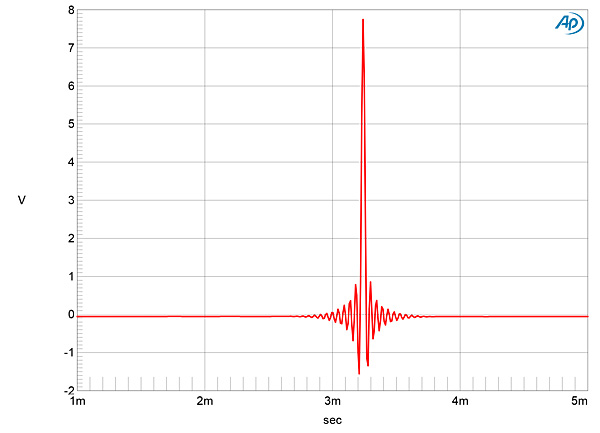
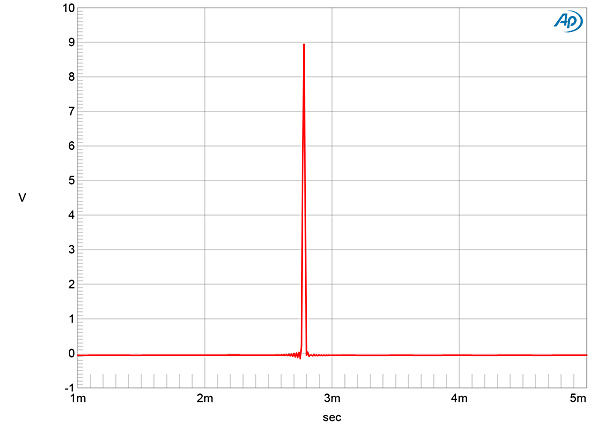
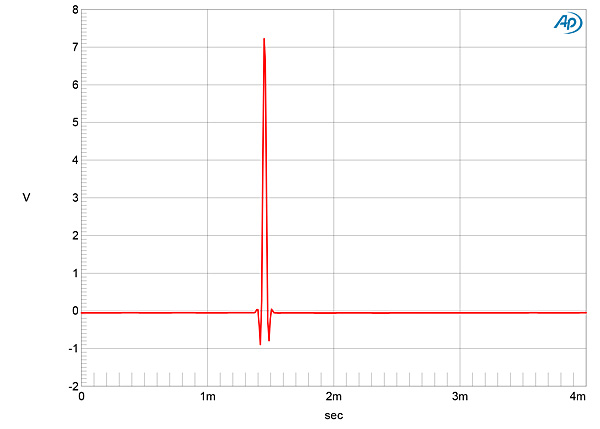
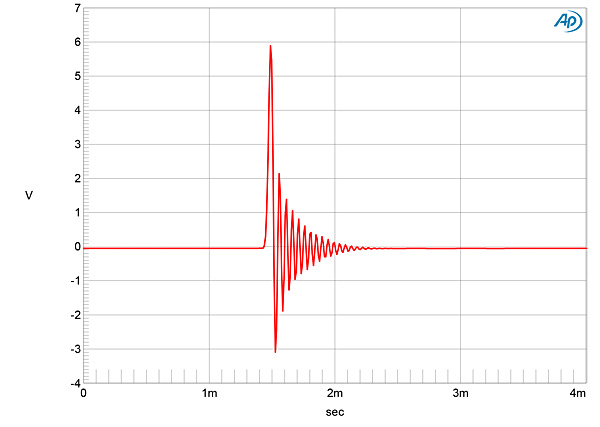
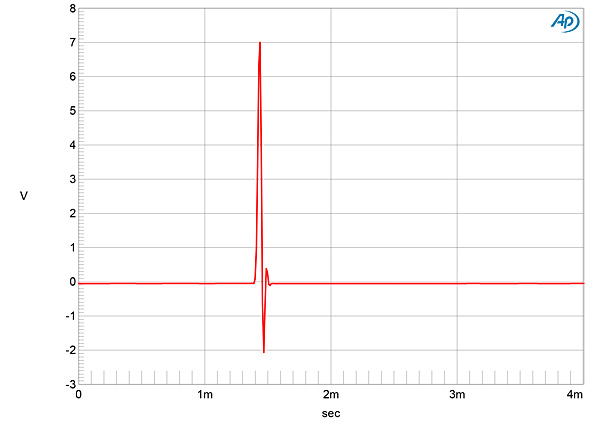
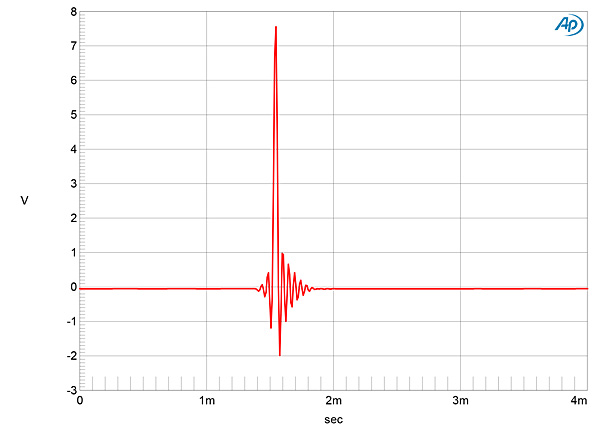
With 44.1kHz-sampled white noise (fig.7, red and magenta traces), the Métronome's response with the Sharp Roll-Off and Short Delay Fast Roll-Off filters did indeed offer a fast rolloff above the audioband, though full stop-band attenuation was delayed by one and a half octaves by a peculiar sculpting of the ultrasonic noise floor. While the third harmonic of a full-scale 19.1kHz tone can be seen at –60dB (0.1%), the aliased image at 25kHz of this tone (blue and cyan traces) is suppressed by 100dB. The shaped ultrasonic noise floor can also be seen in the response with 44.1kHz-sampled white noise and the Slow Roll-Off and Short Delay Slow Roll-Off filters (fig.8, red and magenta traces). As can be anticipated from the names of these filters, many aliased images of the 19.1kHz tone are visible. The latter was also the case with the Super Slow filter, which offered very little suppression of both images and ultrasonic noise, accompanied by sharply defined nulls at 44.1kHz and 88.2kHz (fig.9). With the Low Dispersion Short Delay filter, the c|AQWO's initial rolloff was quick (fig.10) and the aliased image at 25kHz of the high-frequency tone was suppressed by 46dB.
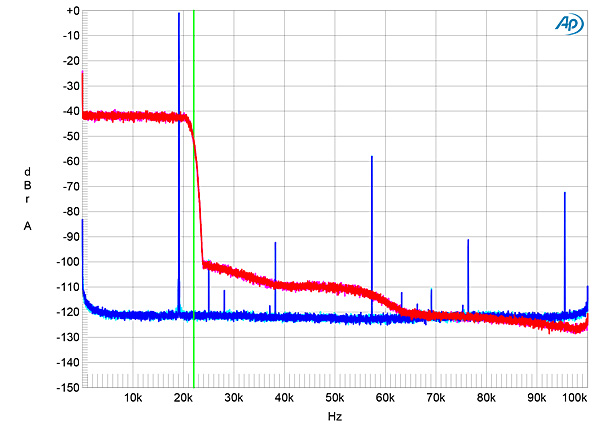
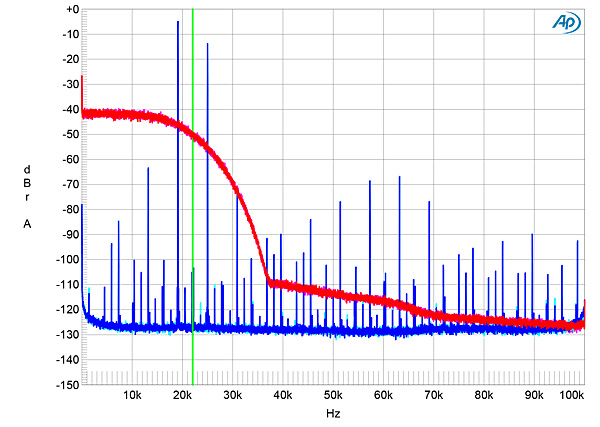
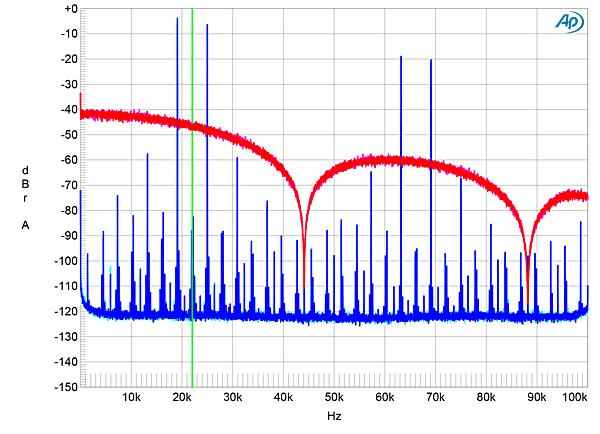
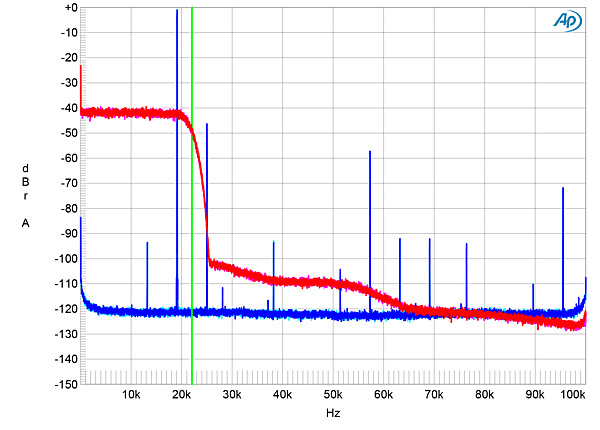
With the two Slow Roll-off filters and 44.1kHz data, the c|AQWO's frequency response was flat up to 10kHz, but down by almost 5dB at 20kHz (fig.11, green and gray traces). The output extended a little higher with data at 96 and 192kHz (cyan, magenta, blue, and red traces), lying at –0.75dB at 20kHz. The response with the Sharp Roll-Off filters followed the same basic shape at all three sample rates (fig.12), but with a sharp rolloff above half of each sample rate. JVS had commented that with the tubes in circuit, there was "a modest diminution of bass slam and less response in the lower octaves." Fig.13 shows the response with 44.1kHz data with the tubed output. (Note the expanded vertical scale compared with figs.11 and 12.) There is indeed a small shelving down of the low frequencies, and the excellent channel matching with the solid-state output has been slightly compromised.
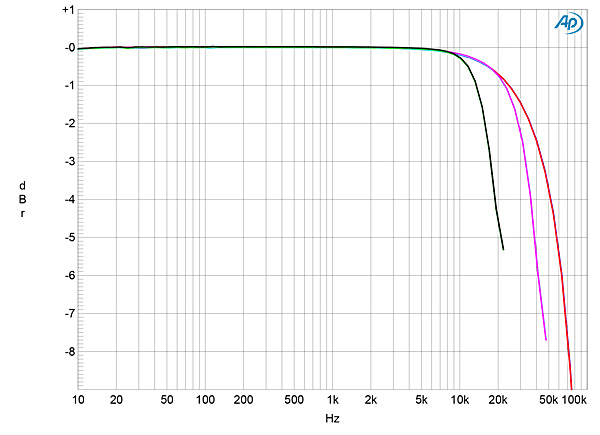
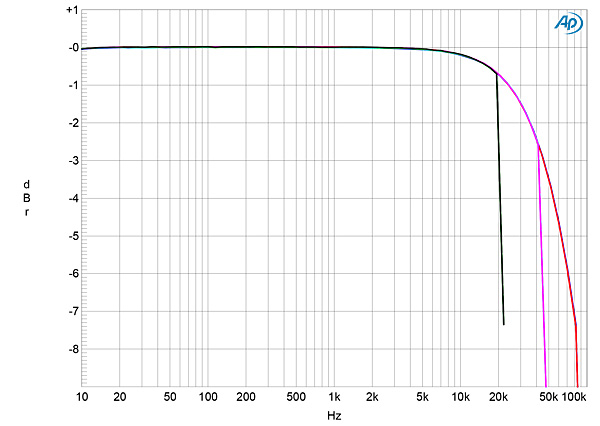
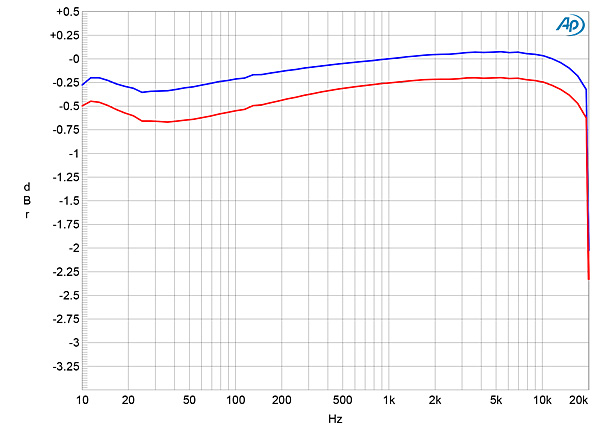
Returning to the solid-state behavior, the Métronome processor's channel separation was superbly high, at >115dB in both directions below 10kHz. The low-frequency noise floor was also very low, and the only supply-related spuriae present were 120Hz at –120dB and 880Hz (1000–120) at –110dB (fig.10, blue and red traces). However, switching the tubes into circuit (fig.14, cyan and magenta traces) increased the level of the random noise by up to 20dB and the 120Hz component now lay at –70dB. Other even-order harmonics of the 60Hz power-line frequency are also now visible.
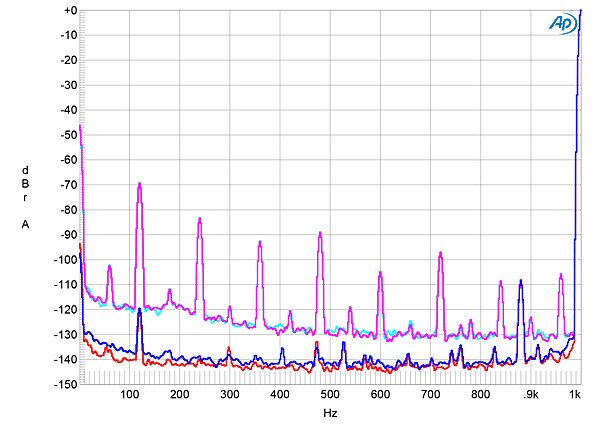
When I switched off the tubes and increased the bit depth from 16 to 24 with a dithered 1kHz tone at –90dBFS (fig.15), the random noise floor dropped by 26dB, meaning that the c|AQWO offers at least 20 bits' worth of resolution. With undithered data representing a tone at exactly –90.31dBFS, the three DC voltage levels described by the data were perfectly resolved (fig.16). With undithered 24-bit data, the result was a clean sinewave (fig.17).
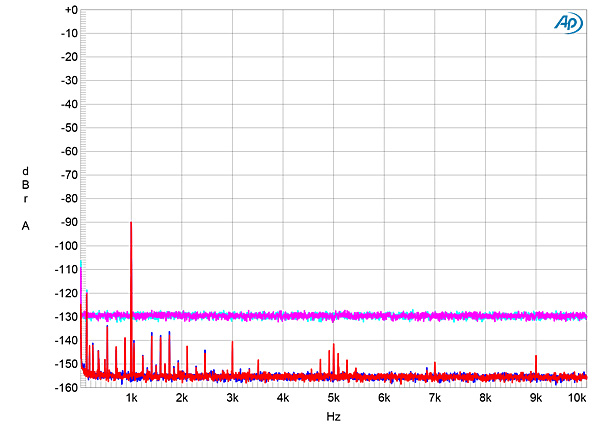
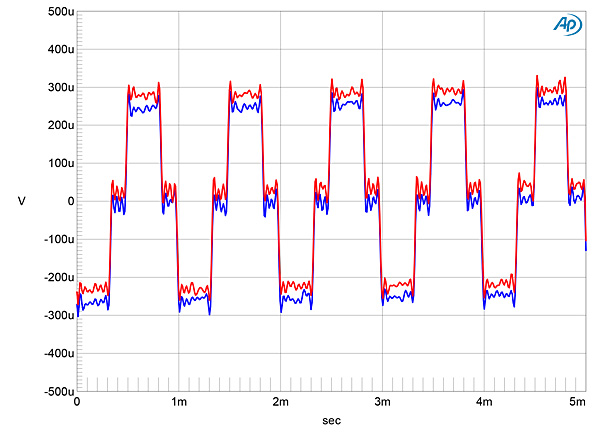
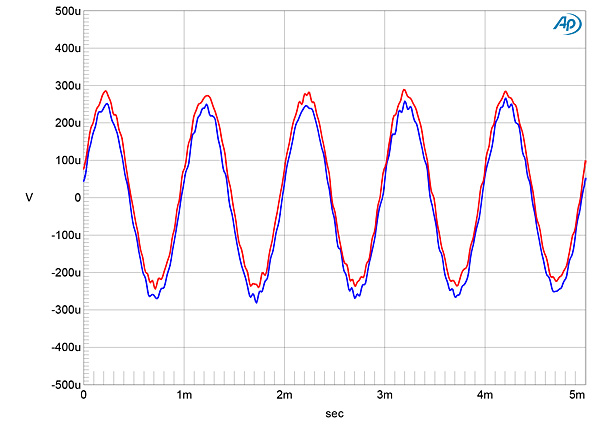
Métronome processor offered very low levels of harmonic distortion. With a full-scale 50Hz tone, the second, third, and fifth harmonics all lay below –90dB or 0.003% (fig.18). The levels of these harmonics didn't rise by any significant amount when I replaced the 100k ohms load with 600 ohms, and while a lot of higher-order harmonics made an appearance under this condition, they all lay below 100dB. The c|AQWO's solid-state output stage is of high quality. However, the same can't be said for the tubed output stage. With the 50Hz, 0dBFS tone, the balanced output (still set at 3V) now had the third harmonic present at just –30dB (3%) and the second at –44dB (0.6%, fig.19). Setting the output level to 2.5V reduced the level of the third harmonic to –40dB (1%), and setting it to 1.4V gave a further reduction to –44dB, with the second now lying at 54dB (0.2%, fig.20). As the c|AQWO's single-ended outputs are 6dB lower in level than the balanced outputs, I repeated all these distortion tests using those outputs and all three output settings, but there was no difference in behavior.
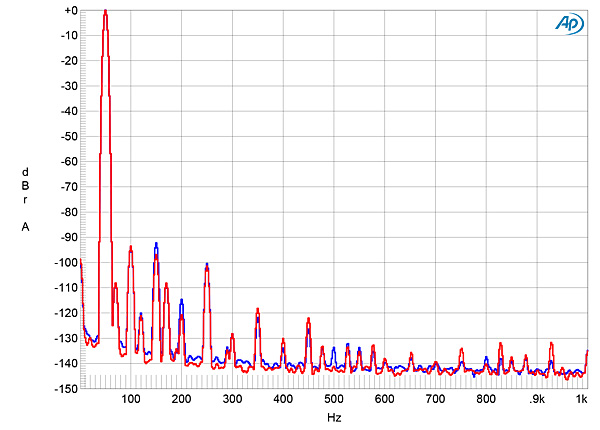
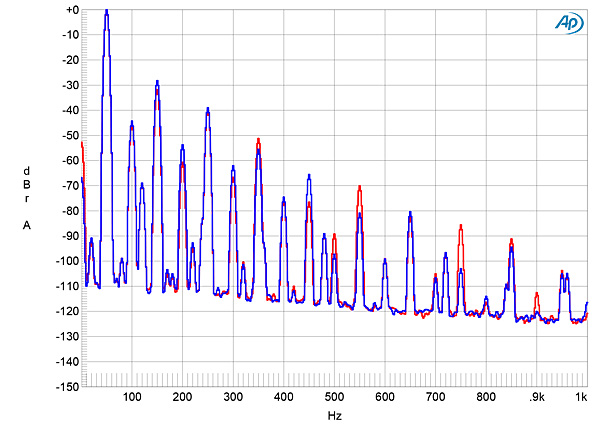
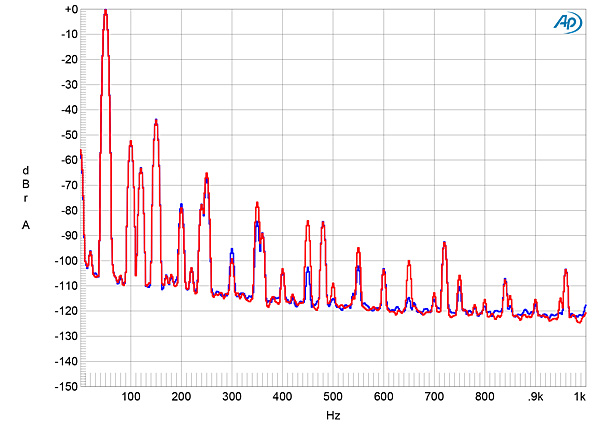
As expected, the Métronome's intermodulation distortion varied with the digital reconstruction filter chosen. With the Low Dispersion Short Delay filter, the second-order difference product produced by equal-level tones at 19 and 20kHz with the combined waveform peaking at –6dBFS lay just below –94dB (0.002%, fig.21). However, a large number of higher-order intermodulation products are present in this graph, with the highest in level, at 18kHz and 21kHz, lying at –64dB (0.03%). The aliased images of the two tones with this filter can also be seen and the levels of these images varied with the Slow Roll-Off filters, or disappeared altogether with the two Sharp Roll-Off filters. When I increased or reduced the signal level by 6dB, the intermodulation products rose or dropped by the same 6dB. However, when I switched the tubes into circuit, most of the higher-order products disappeared, even with a signal peaking at 0dBFS (fig.22), though the second-order difference product now rose to –54dB (0.2%).
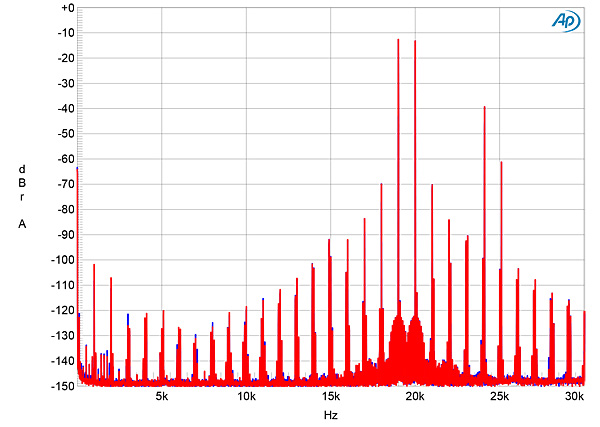
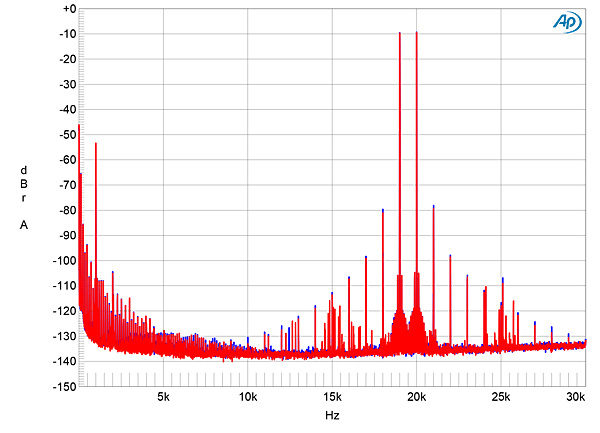
When I tested the Métronome processor for its rejection of word-clock jitter with 16-bit USB data, other than the two closest to the high-level 11.025kHz tone, all the odd-order harmonics of the LSB-level, low-frequency squarewave were at the correct levels (fig.23, sloping green line). A pair of supply-related sidebands at ±120Hz is present, but the noise floor is otherwise very low. Repeating the jitter test by playing a test CD with the t|AQWO transport and connecting it to the c|AQWO with an HDMI cable gave a similar result. However, when I examined the Métronome's rejection of jitter with AES/EBU and TosLink connections, the result was a large number of sidebands spaced at 120Hz (fig.24).
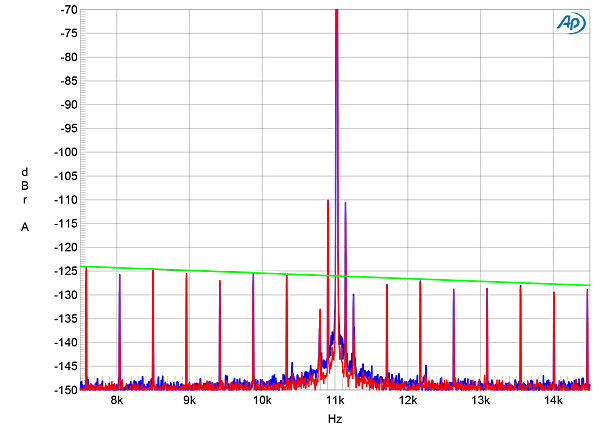
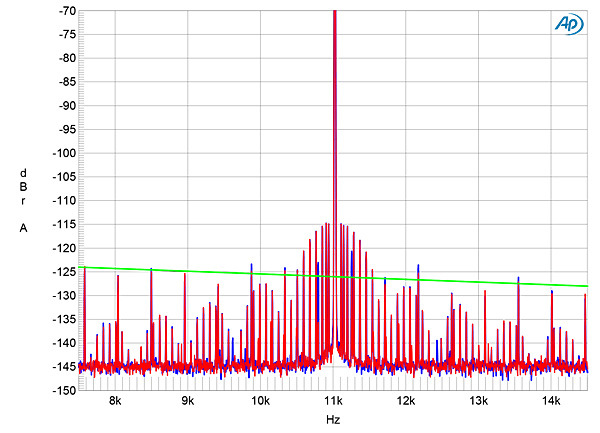
Other than that disappointing result, the Métronome c|AQWO did well on the test bench, at least as far as its solid-state output is concerned. The tubed output, however, suffered from what I feel are excessively high levels of noise and harmonic distortion. YMMV.—John Atkinson

That slow roll-off filter along with the tube output stage should sound good with CDs :-) .........

Metronome Kalista DreamPlay Super Slow roll-off filter also shows similar roll-off on CDs :-) ........

If tube output stage is desired, less expensive iFi Audio Pro iDSD DAC ($2,500, reviewed by Stereophile), could be considered :-) .......

If you want something (kinda) more portable, you could look into Sony DMP-Z1, reviewed by Stereophile ......... It has multiple filters including, slow and super slow roll-off filters :-) .......

pretty sure JVS never goes to big "arena" shows for pop/rock music, and clearly doesn't know much/anyting about live sound reinforcement. That's cool (I know you're primarily an acoustic music guy), but don't try to speak to what you don't know.
Oh, and room/speakers/stage volume will have significantly more effect on the sound than the amps, which have pretty much zero audible effect on the sound. Everyone uses the same few brands (Crown, QSC,etc) of class D amps these days. it's more important for the mics to have good off axis rejection and durability than to be "great" mics. that's why it's mostly dynamic mics that you'll see for live sound regardless of venue size.

those concerts include a Grateful Dead Chinese New Year's Show, sitting / standing / dancing in the exact place where all the speakers converged in the Oakland Coliseum - thank you, friends at Pro Home Systems in Oakland, for getting there at 10 AM to snare the sweet spot - the Rolling Stones in I forget which venue, and a number of amplified operas and concerts in Davies Symphony Hall. Way back, I stood 50 feet from Janis Joplin during an impromptu concert in the main park in St. Louis - one of the most memorable experiences of my life - but the volume was turned down on purpose. Oh, and Patti Labelle and the Bluebells in Oakland's Paramount Theatre. Regardless, glad I brought a smile to your face.

JVS may like the Aurender A30, reviewed by Hi-Fi News ........ It has 7 different filters, including NOS type, slow and super slow roll-off filters :-) ........

JVS could review the latest LG V50, 5G smartphone :-) .......

...... excels in quality, musicality, and an analog feel." quoted Jason Serinus.
All roads lead to Rome.
I enjoy the "imperfections" of vinyl (1000+ LPs 95% classical music) for its "quality, musicality & an analogue feel" withOUT need of spending USD50,000 for the medium players.
vinyl, something imperfect, yet 100% analogue without going through the
tedious imperfect analogue-digital-analogue conversion.
Listening is believing
Jack L
Canada